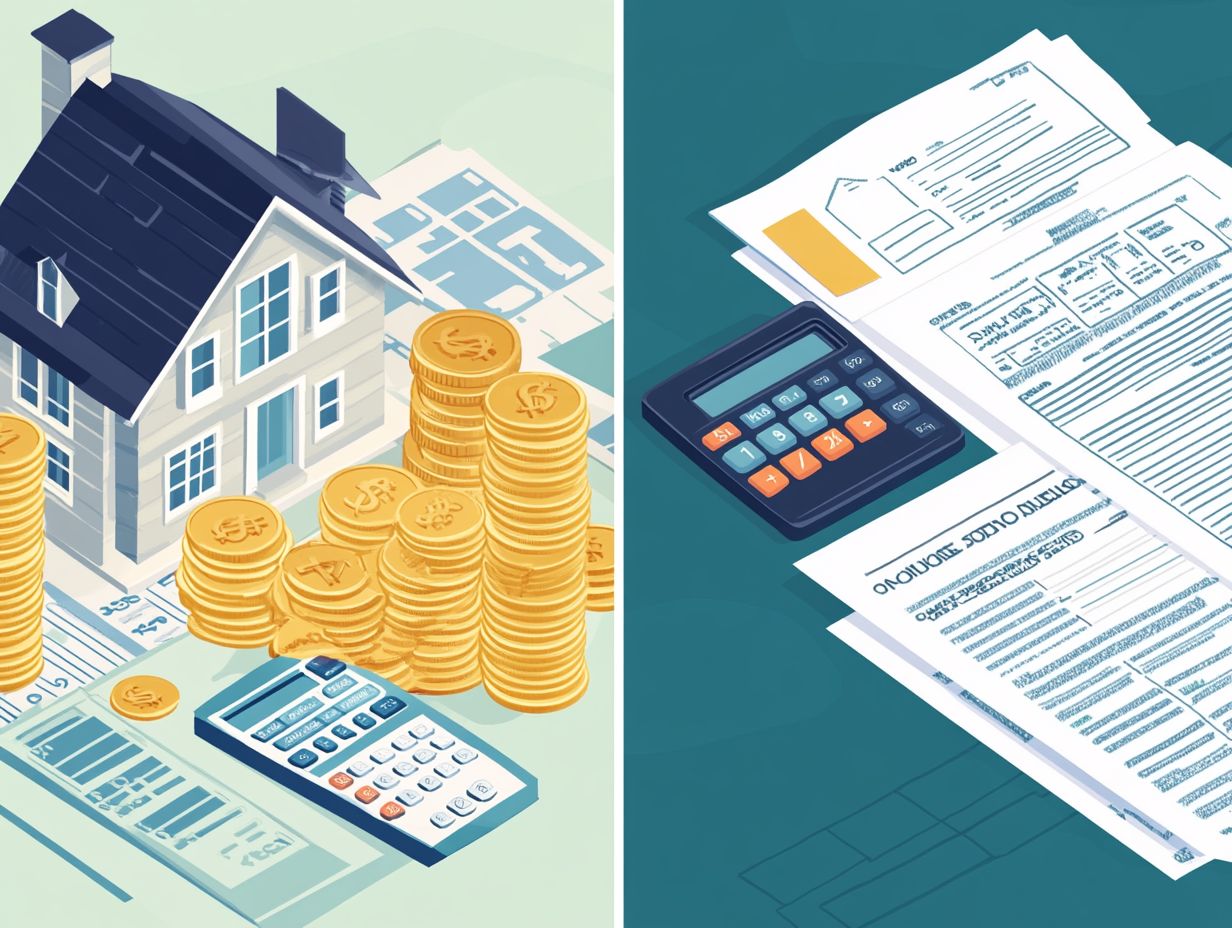Tax Implications for Physical vs. Paper Assets
Navigating the tax landscape can indeed feel like a complex puzzle, especially when it comes to understanding the implications of your assets.
This article delves into the tax considerations linked to both physical and paper assets. From real estate and machinery to stocks and bonds, you ll discover the various types of assets, their unique tax treatments, and the advantages and disadvantages of each.
You will also find planning tips designed to help you maximize your tax benefits, along with insights into potential future changes in taxation. Whether you re an investor or a business owner, understanding the tax implications of your assets is essential for making informed financial decisions.
Contents
- Key Takeaways:
- Tax Implications for Physical Assets
- Tax Implications for Paper Assets
- Comparison of Taxation on Physical vs. Paper Assets
- Tax Planning Strategies for Physical and Paper Assets
- Future Outlook for Taxation on Physical and Paper Assets
- Frequently Asked Questions
- What are the tax implications for physical assets?
- How are paper assets taxed differently from physical assets?
- Can I deduct expenses related to my physical assets on my taxes?
- What are the tax implications for inherited physical assets?
- Are there any special tax considerations for owning both physical and paper assets?
- Which Type of Asset Has a Lower Tax Rate?
Key Takeaways:

- Physical assets, such as real estate and jewelry, can have different tax implications depending on their use and ownership duration.
- Paper assets, such as stocks and bonds, are subject to capital gains tax and can be more easily liquidated for tax purposes.
- Tax planning strategies for physical assets may include minimizing taxable events and taking advantage of deductions, while for paper assets, tax-loss harvesting and tax-deferred accounts can be beneficial.
Tax Implications for Physical Assets
Tax implications for physical assets, particularly in the realm of precious metals like gold and silver, can profoundly influence your financial strategy. Understanding these details is vital!
The Internal Revenue Service (IRS) sets forth specific regulations governing the taxation of these precious metals. You must understand these rules to optimize your tax treatment and ensure compliance when filing your tax return.
Types of Physical Assets
Physical assets encompass a range of tangible investments, including precious metals like gold and silver, which are often regarded as secure options.
These assets act as a hedge against inflation and economic uncertainty, attracting those who wish to diversify their portfolios.
Bullion bars and gold coins, in particular, stand out for their liquidity and intrinsic value, making them appealing choices for anyone looking to safeguard their wealth.
However, investing in physical assets isn t without its risks. Market price fluctuations, the threat of theft, and storage costs can all influence your overall returns. It s crucial to weigh these advantages against the potential challenges, empowering you to make informed and strategic decisions.
Taxation on Physical Assets
Taxation on physical assets, especially those related to capital gains, demands a thorough understanding of IRS regulations and the potential implications for your investments.
If you own properties or collectibles, it’s essential to differentiate between short-term and long-term capital gains, as this distinction directly impacts the tax rates you’ll face. For a deeper understanding of investment options, you might find 5 popular paper asset types explained helpful. Short-term gains, which come from assets held for a year or less, are taxed at ordinary income rates often significantly higher than the preferential rates reserved for long-term gains on assets held for over a year.
To navigate this landscape effectively, you must maintain precise tax documentation. This includes keeping records of purchase prices, sales receipts, and any improvements made to your assets, ensuring compliance and accuracy when filing your taxes.
Grasping these nuances can lead to optimized tax liabilities and ultimately enhance your financial outcomes.
Tax Implications for Paper Assets
Tax implications for paper assets, like gold ETFs and other financial securities, can differ considerably from those associated with physical assets. It’s essential for you to carefully consider your investment strategies to minimize any tax burdens.
Don t miss out on potential savings! Start planning today for a brighter financial future!
Types of Paper Assets

Paper assets primarily include intangible assets like gold ETFs, stocks, and futures contracts. These offer diverse investment options.
These financial instruments let you diversify your portfolio without the hassle of physical ownership. Gold ETFs, for example, act as a hedge against inflation.
Stocks provide potential capital appreciation and dividend income, but they carry market risks. Futures contracts promise high returns but also introduce volatility and leverage risks.
Understanding the characteristics and potential pitfalls of these assets is key to making informed investment decisions.
Taxation on Paper Assets
The taxation of paper assets is often more complex than that of physical assets. Different tax treatments and reporting obligations play a role.
This complexity arises from the differences between short-term and long-term capital gains. Assets held for over a year usually enjoy lower tax rates.
As an investor, remember that any deductions you claim can significantly affect your tax burden. Proper documentation and accurate reporting of gains or losses during tax season are essential.
While this landscape may seem daunting, grasping these details is vital for effective financial planning.
Comparison of Taxation on Physical vs. Paper Assets
Comparing the taxation of physical assets with paper assets reveals significant differences in capital gains tax and other implications. These differences can impact your investment strategies.
Understanding these nuances is essential for optimizing your portfolio in today’s financial landscape.
Pros and Cons of Each Type of Asset
Knowing the pros and cons of physical versus paper assets is crucial for wealth management. Each asset class has unique characteristics that can shape your portfolio strategy.
Physical assets, like real estate and precious metals, carry tangible value and can hedge against inflation. However, they come with maintenance costs and market fluctuations.
On the other hand, paper assets like stocks and bonds offer superior liquidity. Still, they can be vulnerable to market volatility and regulatory changes.
Tax treatment differs for these assets, impacting your long-term gains and cash flow. Don t delay weigh your options carefully before diving into either investment path.
Tax Planning Strategies for Physical and Paper Assets
Implementing effective tax planning strategies for your physical and paper assets can enhance your tax benefits and optimize your investment returns. This approach will significantly impact your financial planning.
Maximizing Tax Benefits

To maximize your tax benefits, understanding tax deductions and credits is essential. You can use these tools effectively across various investment opportunities.
By analyzing your assets, you can identify deductions and credits that may lower your tax burden. For instance, homeowners can benefit from mortgage interest deductions, and investing in renewable energy projects might qualify you for valuable credits.
If you have education-related expenses, tax credits can help reduce those tuition costs. Businesses can also take advantage of tax deductions for operational expenses to boost cash flow.
Grasping these aspects empowers you to make informed financial decisions that enhance your tax situation.
Future Outlook for Taxation on Physical and Paper Assets
The taxation landscape for physical and paper assets is changing. Influenced by IRS regulations, economic uncertainties, and ongoing tax reform discussions, these factors will impact your investment strategies.
It’s crucial to stay informed and adaptable in this dynamic landscape.
Predictions and Potential Changes
Understanding potential changes in tax implications for physical and paper assets offers you invaluable insights for proactive planning. As tax reform discussions intensify, keep an eye on changes to capital gains tax rates.
Changes in these rates could affect both individuals and institutional investors, prompting you to rethink your asset allocation strategy. Shifting towards tax-advantaged accounts or investments with lower capital gains may be wise.
Stay informed about regulatory updates to align your financial strategies with evolving tax implications. This knowledge can enhance your long-term wealth accumulation.
Frequently Asked Questions
What are the tax implications for physical assets?
The tax implications for physical assets like real estate or gold vary based on use. Generally, you incur capital gains tax when sold for a profit and property taxes while owned.
How are paper assets taxed differently from physical assets?

Paper assets, such as stocks or bonds, follow different tax rules. They incur capital gains tax rates, and dividends and interest income are taxed as regular income.
Yes, certain expenses related to physical assets may be deductible. For example, rental property owners can deduct expenses like mortgage interest and repairs.
What are the tax implications for inherited physical assets?
If you inherit a physical asset like a house or land, the tax implications depend on its value at inheritance. Generally, inherited assets receive a step-up in basis, meaning you only pay taxes on the profit made from selling them after the inheritance value.
Are there any special tax considerations for owning both physical and paper assets?
Yes, owning both types of assets comes with unique tax implications. If you hold both stocks and real estate, you may be subject to capital gains tax and property tax. Consulting a tax professional is important to understand the impact on your overall taxes.
Which Type of Asset Has a Lower Tax Rate?
When it comes to taxes, paper assets usually have a lower rate than physical assets. Long-term capital gains tax on paper assets can be as low as 0%!
In contrast, physical assets can face capital gains taxes as high as 20%. It s crucial to understand these tax implications when making investment decisions.
Understanding capital gains tax is essential for investors. This tax applies to the profit made from selling an asset, such as stocks or real estate.
Ready to make informed investment choices? Consider how the type of asset you choose can affect your tax rate!















